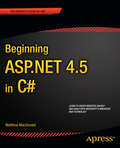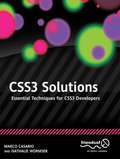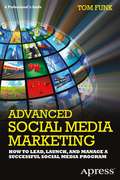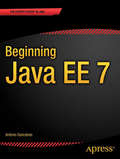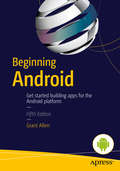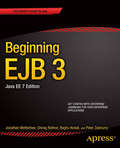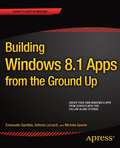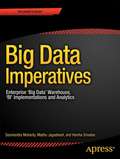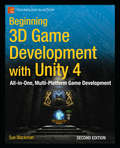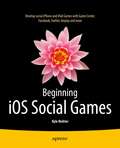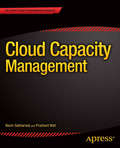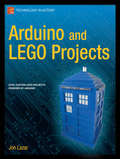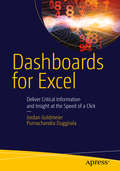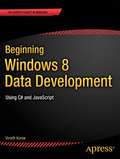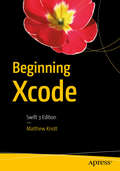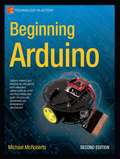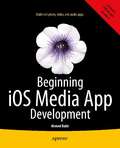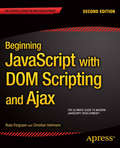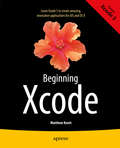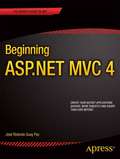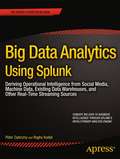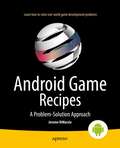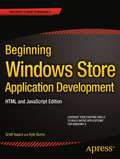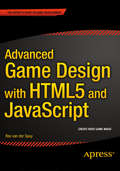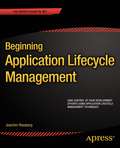- Table View
- List View
Beginning ASP.NET 4.5 in C#
by Matthew MacdonaldThis book is the most comprehensive and up to date introduction to ASP. NET ever written. Focussing solely on C#, with no code samples duplicated in other languages, award winning author Matthew MacDonald introduces you to the very latest thinking and best practices for the ASP. NET 4. 5 technology. Assuming no prior coding experience, you'll be taught everything you need to know from the ground up. Starting from first principals, you'll learn the skills you need to be an effective ASP. NET developer who is ready to progress to more sophisticated projects and professional work. You'll be taught how to use object orientation and code-behind techniques to lay out your code clearly in a way other developers can easily understand. You'll learn how to query databases from within you web pages, spice up your layouts using ASP. NET AJAX and deploy your finished websites to production servers. You'll also learn how to debug your code when things go wrong and the performance and scalability issues that can affect your web projects as they grow. With you book you can take your first step towards becoming a successful ASP. NET developer with confidence. What you'll learn Learn everything you need to know to build ASP. NET 4. 5 applications with confidence. Dive into the deepest, broadest, introductory ASP. NET coverage available. Be guided by an award winning author who will steadily progress your knowledge from first principles to advanced techniques over the course of the book. Who this book is for This book is ideal for anyone new to . NET development who wants to learn how ASP. NET 4. 5 works. No prior programming knowledge is assumed and all concepts are explained from first principals. Table of Contents 1. The . NET Framework 2. The C# Language 3. Types, Objects, and Namespaces 4. Visual Studio 5. Web Form Fundamentals 6. Web Controls 7. Error Handling, Logging, and Tracing 8. State Management 9. Validation 10. Rich Controls 11. User Controls and Graphics 12. Styles, Themes, and Master Pages 13. Website Navigation 14. ADO. NET Fundamentals 15. Data Binding 16. The Data Controls 17. Files and Streams 18. XML 19. Security Fundamentals 20. Membership 21. Profiles 22. Advanced ASP. NET Components 23. Caching 24. LINQ and the Entity Framework 25. ASP. NET AJAX 26. Deploying ASP. NET Applications
CSS3 Solutions: Essential Techniques for CSS3 Developers
by Marco Casario Anselm Bradford Jonathan Reid Nathalie Wormser Dan Saltzman Francesco Improta Aaron CongletonCSS3 brings a mass of changes, additions, and improvements to CSS across a range of new modules. Web designers and developers now have a whole host of new techniques up their sleeves, from working with colors and fonts accurately, to using media queries to ensure correct styling across a multitude of devices. But all of these new technologies bring more tags to learn and more avenues for things to go wrong. CSS3 Solutions provides a collection of solutions to all of the most common CSS3 problems. Every solution contains sample code that is production-ready and can be applied to any project. What you'll learn Real-world solutions for everyday CSS3 development, saving hours of frustration. Problems covered include: Developing across multiple devices Design patterns for user experience and mobile Working with the CSS box model Who this book is for Web developers and designers seeking practical advice on making CSS3 work. Table of Contents CSS Basics CSS Selectors Font, Text and Color CSS Typography Tables and Lists CSS Box Model CSS Positioning and Layouts Multidevice Development Transitions and Transformations Multimedia and Accessibility UX Patterns Mobile UX Patterns
Advanced Social Media Marketing: How to Lead, Launch, and Manage a Successful Social Media Program
by Tom FunkThey are laborers, soldiers, refugees, and orphans. In areas of the world torn by poverty, disease, and war, millions of children are invisible victims, deprived of home, family, and basic human rights. Their chances for a stable adult life are extremely slim. The powerful interdisciplinary volume Vulnerable Children brings a global child-rights perspective to the lives of indigenous, refugee, and minority children in and from?crisis-prone regions. Focusing on self-determination, education, security, health, and related issues, an international panel of scholars examines the structural and political sources of children''s vulnerabilities and their effects on development. The book analyzes intervention programs currently in place and identifies challenges that must be met at both the community and larger policy levels. These chapters also go a long way to explain the often-blurred line between vulnerability and resilience. Included in the coverage: Dilemmas of rights-based approaches to child well-being in an African cultural context. Poverty and minority childrenOCOs education in the U. S. : case study of a Sudanese refugee family. The heterogeneity of young childrenOCOs experiences in Kenya and Brazil. A world tour of interventions for children of a parent with a psychiatric illness. An exploration of fosterage of Owambo orphans in Namibia. UNICEF in Colombia: defending and nurturing childhood in media, public, and policy discourses. Vulnerable Children is a must-have volume for researchers, graduate students, and clinicians/professionals/practitioners across a range of fields, including child and school psychology, social work, maternal and child health, developmental psychology, anthropology, sociology, social policy, and public health"
Beginning Java EE 7
by Antonio GoncalvesJava Enterprise Edition (Java EE) continues to be one of the leading Java technologies and platforms. Beginning Java EE 7 is the first tutorial book on Java EE 7. Step by step and easy to follow, this book describes many of the Java EE 7 specifications and reference implementations, and shows them in action using practical examples. This definitive book also uses the newest version of GlassFish to deploy and administer the code examples. Written by an expert member of the Java EE specification request and review board in the Java Community Process (JCP), this book contains the best information possible, from an expert's perspective on enterprise Java technologies.
Beginning Android: Develop For Android Using Html5, Css3, And Javascript
by Grant AllenGet started in creating marketable apps for the burgeoning Android market. Begin your journey by learning the essentials of programming for phones and tables that are built around Google's wildly-successful Android platform. Beginning Android, Fifth Edition is fresh with details on the latest iteration of the Android 5 and earlier versions. Google's Android operating-system has taken the industry by storm, going from its humble beginnings as a smartphone operating system to its current status as a platform for apps that run across a gamut of devices from phones to tablets to netbooks to televisions, and the list is sure to grow. Smart developers are not sitting idly by in the stands, but are jumping into the game of creating innovative and salable applications for this fast-growing, mobile- and consumer-device platform. If you're not in the game yet, now is your chance! Begin at the beginning by installing the tools and compiling a skeleton app. Move through creating layouts, employing widgets, taking user input, and giving back results. Soon you'll be creating innovative applications involving multi-touch, multi-tasking, and more! You'll be drawing data live from the Internet using web services and delighting your customers with life-enhancing apps. Not since the PC era first began has there been this much opportunity for the common developer. What are you waiting for? Grab your copy of Beginning Android and get started! What you'll learn Develop Java-based mobile applications and games for a wide range of phones and devices. Create user interfaces using WebKit and the Android widget framework. Incorporate activities, services, content providers, and broadcast receivers into your applications. Support multiple Android versions, multiple screen sizes, and other device-specific characteristics. Build and experience the array of new WebM video and other multimedia APIs for Android and more. Who this book is for Beginning Android is aimed at programmers new to Android application development who desire to create marketable applications for the burgeoning market of smartphone, tablet, and other Android device users. Table of Contents Part I: Get Android and Get Coding! 1. Welcome to Android 2. Ready, Set, Code! 3. Inside Your First Android Project 4. Changing and Improving Your Project Part II: Activities and the User Interface 5. Layouts and UI Design 6. Android Widgets 7. Containers, Lists, and Adapters 8. Input Methods, Fonts, Menus, and Dialogs 9. The Action Bar 10. The Lifecycle of an Activity III: A World of Wonderful Devices and Screens 11. Devices of All Sizes 12. Phone Calls! 13. Audio and Sound Support 14. Image and Video Handling 15. A Device of Devices IV: Working with Resources and Services 16. Working with Files 17. Working with Local Databases 18. Working with Preferences 19. Controlling Security and Permissions 20. More Power from Java Libraries 21. Using External Libraries 22. Calling on Services 23. Generating Notifications
Beginning EJB 3: Java EE 7 Edition (Beginning: From Novice To Professional Ser.)
by Jonathan Wetherbee Chirag Rathod Raghu Kodali Peter ZadroznyDevelop powerful, standards-based, back-end business logic with Beginning EJB 3, Java EE 7 Edition. Led by an author team with 20 years of combined Enterprise JavaBeans experience, you'll learn how to use the new EJB 3. 2 APIs. You'll gain the knowledge and skills you'll need to create the complex enterprise applications that run today's transactions and more. Targeted at Java and Java EE developers, with and without prior EJB experience, Beginning EJB 3 is packed with practical insights, strategy tips, and code examples. As each chapter unfolds, you'll not only explore a new area of the spec; you'll also see how you can apply it to your own applications through specific examples. Beginning EJB 3 will serve not only as a reference, but it will also function as a how-to guide and repository of practical examples to which you can refer as you build your own applications. It will help you harness the power of EJBs and take your Java EE 7 development to the next level. What you'll learn How to employ session beans, message-driven beans, and entity beans How to use the updated EJB 3 persistence and object-relational mappings How to choose which EJB option is right for your application How to enrich your application's behavior with CDI services How to test the EJB container inside and out How to migrate from older EJB to the newest EJB APIs Who this book is for This book is for those Java and Java EE developers with and without prior EJB experience. Table of Contents Introduction to the EJB 3 Architecture Session Beans Entities and the Java Persistence API Advanced Persistence Features Message-Driven Beans EJB and Web Services Integrating Session Beans, Entities, Message-Driven Beans, and Web Services Transaction Management EJB Performance and Testing Context and Dependency Injection (CDI) Packaging and Deployment EJB Client Applications EJB Runtime Environments
Building Windows 8.1 Apps from the Ground Up
by Emanuele Garofalo Antonio Liccardi Michele AponteThis book is the perfect introduction for anyone wanting to create sophisticated Windows 8 apps for the first time. Assuming only a basic knowledge of HTML and CSS we'll walk you through the development process using C# and VB. The book will familiarize you with the tools you'll need to use in order to make the most of Windows' stunning new features. You'll discover how to take advantage of the built-in functionality to create high quality user experiences. What you'll learn How to plan out your app and its user-experience The pros and cons of the different development languages available to you To build well-structured apps that can be easily customized and reused Manage data stores and cloud storage Why accessibility and globalization matter, even to the smallest of apps Use Windows 8's features to interact with the world around you Who this book is for This book is ideal for anyone with a little programming knowledge (basic HTML and CSS is all you'll need) who want to start creating Windows 8 apps. This book will walk you through everything you need to know in a results-oriented way and ensure your first Windows 8 apps built on firm foundations that you can be proud of. Table of Contents 1. Introduction to Windows 8. 1 2. Windows Runtime Environment 3. Designing the User Experience 4. Choose Your Way 5. Managing the Application Life Cycle 6. Start Up Your App 7. Take Advantage of the Environment 8. Data Management 9. Listening to the World 10. Accessibility and Globalization 11. Sell Your App 12. Live Tile and Toast Templates 13. Windows Store Developer Account
Big Data Imperatives: Enterprise Big Data Warehouse, BI Implementations and Analytics
by Soumendra Mohanty Harsha Srivatsa Madhu JagadeeshBig Data Imperatives, focuses on resolving the key questions on everyone's mind: Which data matters? Do you have enough data volume to justify the usage? How you want to process this amount of data? How long do you really need to keep it active for your analysis, marketing, and BI applications? Big data is emerging from the realm of one-off projects to mainstream business adoption; however, the real value of big data is not in the overwhelming size of it, but more in its effective use. This book addresses the following big data characteristics: Very large, distributed aggregations of loosely structured data - often incomplete and inaccessible Petabytes/Exabytes of data Millions/billions of people providing/contributing to the context behind the data Flat schema's with few complex interrelationships Involves time-stamped events Made up of incomplete data Includes connections between data elements that must be probabilistically inferred Big Data Imperatives explains 'what big data can do'. It can batch process millions and billions of records both unstructured and structured much faster and cheaper. Big data analytics provide a platform to merge all analysis which enables data analysis to be more accurate, well-rounded, reliable and focused on a specific business capability. Big Data Imperatives describes the complementary nature of traditional data warehouses and big-data analytics platforms and how they feed each other. This book aims to bring the big data and analytics realms together with a greater focus on architectures that leverage the scale and power of big data and the ability to integrate and apply analytics principles to data which earlier was not accessible. This book can also be used as a handbook for practitioners; helping them on methodology,technical architecture, analytics techniques and best practices. At the same time, this book intends to hold the interest of those new to big data and analytics by giving them a deep insight into the realm of big data.
Beginning 3D Game Development with Unity 4: All-in-one, multi-platform game development
by Sue BlackmanBeginning 3D Game Development with Unity 4 is perfect for those who would like to come to grips with programming Unity. You may be an artist who has learned 3D tools such as 3ds Max, Maya, or Cinema 4D, or you may come from 2D tools such as Photoshop and Illustrator. On the other hand, you may just want to familiarize yourself with programming games and the latest ideas in game production. This book introduces key game production concepts in an artist-friendly way, and rapidly teaches the basic scripting skills you'll need with Unity. It goes on to show how you, as an independent game artist, can create interactive games, ideal in scope for today's casual and mobile markets, while also giving you a firm foundation in game logic and design. The first part of the book explains the logic involved in game interaction, and soon has you creating game assets through simple examples that you can build upon and gradually expand. In the second part, you'll build the foundations of a point-and-click style first-person adventure game--including reusable state management scripts, dialogue trees for character interaction, load/save functionality, a robust inventory system, and a bonus feature: a dynamically configured maze and mini-map. With the help of the provided 2D and 3D content, you'll learn to evaluate and deal with challenges in bite-sized pieces as the project progresses, gaining valuable problem-solving skills in interactive design. By the end of the book, you will be able to actively use the Unity 3D game engine, having learned the necessary workflows to utilize your own assets. You will also have an assortment of reusable scripts and art assets with which to build future games. What you'll learn How to build interactive games that work on a variety of platforms Take the tour around Unity user interface fundamentals, scripting and more Create a test environment and gain control over functionality, cursor control, action objects, state management, object metadata, message text and more What is inventory logic and how to manage it How to handle 3D object visibility, effects and other special cases How to handle variety of menus and levels in your games development How to handle characters, scrollers, and more How to create or integrate a story/walkthrough How to use the new Mecanim animation Who this book is for Students or artists familiar with tools such as 3ds Max or Maya who want to create games for mobile platforms, computers, or consoles, but with little or no experience in scripting or the logic behind games development. Table of Contents 01. Introduction to Game Development 02. Unity UI basics 03. Introduction to Scripting 04. Terrain Generation and Environment 05. Exploring Navigation 06. Cursor Control and Interaction 07. Importing Assets 08. Action Objects 09. Managing State 10. Exploring Transitions 11. Physics and Special Effects 12. Message Text and HUD 13. Inventory Logic 14. Managing Inventory 15. Dialogue Trees 16. Mecanim 17. Game Environment 18. Setting up the Game 19. Menus and Levels
Beginning iOS Social Games
by Kyle RichterIt's certainly fun to build games that run on your iPhone and iPad. But, wouldn't it be more fun to create games that allow you to play with other gamers in your social network? There's a whole lot more things you can do. Most of the top best selling games around the world, like World of Warcraft, let you play with others online and share your experiences with your friends. Beginning iOS Social Games is your concise introduction to iOS social and other networked gaming app development using iOS Game Center, Game Kit, Store Kit, AirPlay, iOS 7 Game Controllers, iTunes App Store and integrating with social networks/media like Facebook and Twitter. Author Kyle Richter of Empirical Development is an expert game developer who guides you through the social game app development process step by step. This book may allow you to turn your already existing, created game into a well polished networkable and/or social media capable game app. What you'll learn Build socially integrated games on iOS for iPhone and iPad using Twitter and Facebook Configure and begin using Game Center, Apple's social gaming platform Work with the advanced features of Apple's Game Center using leaderboards, achievements, matchmaking, invitations, and multiplayer Exchange data while dealing with errors, dropped connections and other hurdles Create turned-based iOS games using Game Center Implement other socially rich features like real time Voice Chat, In App Purchases with Store Kit, and displaying content on a TV using Airplay Explore all these features and more while building a real iOS game, UFOs! Who this book is for This book is for iPhone and iPad app developers looking to build iOS game apps that can network with other apps and social media like Facebook. Table of Contents Chapter 1: Getting Started With Social Gaming Chapter 2: Game Center: Setting Up and Getting Started Chapter 3: Leaderboards Chapter 4: Achievements Chapter 5: Matchmaking and Invitations Chapter 6: The Peer Picker Chapter 7: Network Design Overview Chapter 8: Exchanging Data Chapter 9: Turned-Based Gaming with Game Center Chapter 10: Voice Chat Chapter 11: In-App Purchase With Store Kit Chapter 12: Twitter Chapter 13: Facebook Integration Chapter 14: AirPlay Chapter 15: Game Controllers
Cloud Capacity Management: Capacity Management
by Navin Sabharwal Prashant WaliCloud Capacity Management helps readers in understanding what the cloud, IaaS, PaaS, SaaS are, how they relate to capacity planning and management and which stakeholders are involved in delivering value in the cloud value chain. It explains the role of capacity management for a creator, aggregator, and consumer of cloud services and how to provision for it in a 'pay as you use model'. This involves a high level of abstraction and virtualization to facilitate rapid and on demand provisioning of services. The conventional IT service models take a traditional approach when planning for service capacity to provide optimum services levels which has huge cost implications for service providers. This book addresses the gap areas between traditional capacity management practices and cloud service models. It also showcases capacity management process design and implementation in a cloud computing domain using ITSM best practices. This book is a blend of ITSM best practices and infrastructure capacity planning and optimization implementation in various cloud scenarios. Cloud Capacity Management addresses the basics of cloud computing, its various models, and their impact on capacity planning. This book also highlights the infrastructure capacity management implementation process in a cloud environment showcasing inherent capabilities of tool sets available and the various techniques for capacity planning and performance management. Techniques like dynamic resource scheduling, scaling, load balancing, and clustering etc are explained for implementing capacity management. This book also covers emerging techniques in the cloud capacity management area: Self learning systems Yield management Proactive capacity planning
Arduino and LEGO Projects
by Jon LazarWe all know how awesome LEGO is, and more and more people are discovering how many amazing things you can do with Arduino. In Arduino and LEGO Projects, Jon Lazar shows you how to combine two of the coolest things on the planet to make fun gadgets like a Magic Lantern RF reader, a sensor-enabled LEGO music box, and even an Arduino-controlled LEGO train set. Learn that SNOT is actually cool (it means Studs Not on Top) See detailed explanations and images of how everything fits together Learn how Arduino fits into each project, including code and explanations Whether you want to impress your friends, annoy the cat, or just kick back and bask in the awesomeness of your creations, Arduino and LEGO Projects shows you just what you need and how to put it all together.
Dashboards for Excel
by Jordan Goldmeier Purnachandra DuggiralaThe book takes a hands-on approach to developing dashboards, from instructing users on advanced Excel techniques to addressing dashboard pitfalls common in the real world. Dashboards for Excel is your key to creating informative, actionable, and interactive dashboards and decision support systems. Throughout the book, the reader is challenged to think about Excel and data analytics differently--that is, to think outside the cell. This book shows you how to create dashboards in Excel quickly and effectively. In this book, you learn how to: Apply data visualization principles for more effective dashboards Employ dynamic charts and tables to create dashboards that are constantly up-to-date and providing fresh information Use understated yet powerful formulas for Excel development Apply advanced Excel techniques mixing formulas and Visual Basic for Applications (VBA) to create interactive dashboards Create dynamic systems for decision support in your organization Avoid common problems in Excel development and dashboard creation Get started with the Excel data model, PowerPivot, and Power Query What you'll learn Learn the visualization tools, charts, tables, and graphs important to management. Understand what management doesn't want to see in a report Turn around dashboards faster and cheaper than ever before Understand the key role dashboards play in an organization Analyze real-world dashboards to apply important features to your own organization Utilize understated, but powerful, Excel formulas and VBA code Avoid common pitfalls in Excel development and dashboard creation Get started with the Excel data model, PowerPivot, and Power Query Who this book is for This book is for many people. It's for the developer who isn't satisfied by accepting Excel's so-called limitations, who feels that with some creativity, spreadsheets can become a powerful and informative decision engine. It's for the Excel user who has spent hours--even outside of work--experimenting with Excel formulas and macros in an attempt to find a better, more efficient way to complete a task. It's for the user who believes in the power of the spreadsheet. Table of Contents Part I. Dashboards and Data Visualization 1. Introduction to Dashboard and Decision Support Development 2. A Critical View of Information Visualization 3. The Principles of Data Visualization in Microsoft Excel 4. The Excel Data Presentation Library Part II. Excel Dashboard Design Tools and Concepts 5. Getting Started: Thinking Outside the Cell 6. Visual Basic for Applications for Excel, a Refresher 7. Avoiding Common Pitfalls in Development and Design 8. The Elements of Good Excel Dashboards and Decision Support Systems Part III. Formulas, Controls, and Charts 9. Introducing Formula Concepts 10. Advanced Formula Concepts 11. Metrics: Performance and Context 12. Charts with Heart (or, How to Avoid a Chart Attack) 13. Creating an Interactive Gantt Chart Dashboard 14. An Interactive Gantt Chart Dashboard, Data Visualization 15. An Interactive Gantt Chart Dashboard, Data Details on Demand Part IV. From User Interface to Presentation 16. Working with Form Controls 17. Getting Input from Users 18. Storage Patterns for User Input 19. Building for Sensitivity Analysis 20. Perfecting the Presentation Part V. Data Models, PowerPivot, and Power Query 21. Data Model Capabilities of Excel 2013 22. Advanced Modeling with Slicers, Filters, and Pivot Tables 23. Introduction to Power Query 24. Introduction to PowerPivot
Beginning Windows 8 Data Development: Using C# and JavaScript
by Vinodh KumarThis book introduces novice developers to a range of data access strategies for storing and retreiving data both locally and remotely. It provides you with a range of fully working data access solutions and the insight you need to know when, and how, to apply each of the techniques to best advantage. Focussing specifically on how the Windows 8 app developer can work with the Windows Runtime (often called Windows RT) framework this book provides careful analysis of the many options you have open to you, along with a comparision of their strengths and weaknesses under different conditions. With the days of a single database being the right choice for almost all development projects long gone. You will lean that the right choice for your app now depends on a variety of factors and getting it right will be critical to your customer's end user experience. We cover a range of data access strategies ranging from storing and retrieving data locally using the JET API, to using the most popular open and closed source database products like SQLite and SQL Server. We look at how lightweight HTML and JavaScript apps work well with equally feather-weight data stores like IndexedDB. We'll also introduce you to more advanced data access techniques like REST (JSON), WCF RIA Services, ASP. NET MVC 4 Web API and Windows Azure that can hugely expand the horizons of what it is possible for your app to do as storage - and even processing - are taken beyond the confines of your user's device. By the time you have read this book you will be familiar with the key data access considerations you will need to evaluate as you build you apps and you will be able to confidently select the data access architecture that is most appropriate to the app you want to build. What you'll learn Understand the data access capability of WinRT Explore the various data access strategies Understand local storage in Windows 8 Apps Discover how to use HTML5 indexedDB as an offline database Use SQLite and SQL Server with Windows 8 Apps Develop ASP. NET MVC 4 Web API data stores Learn how to consume data through a WCF Service Integrate your app with Public Web Services using REST See how SQL Azure can extend your Windows 8 Apps Who this book is for This book is for all the . NET, iOS, Android and Windows Phone app developers looking to develop data driven Windows 8 style apps. You should be comfortable with basic programming concepts and have worked with simple data stores previously. Table of Contents Introducing Windows 8 development from a data perspective Windows 8 Modern app data access strategies Selecting the right strategy for your app Local Data Access I : JET API Local Data Access: II: IndexedDB Dealing with Application Data WCF RIA Services ASP. NET Web API SQL Databases Windows Phone 8 Data Access
Beginning Xcode: Swift 3 Edition
by Matthew KnottXcode is Apple's Integrated Development Environment (IDE), Interface Builder, and other tools for helping app developers and coders to build iPhone and iPad apps more efficiently and quickly. Beginning Xcode aims to get you up and running with Apple's latest Xcode 5 and includes a wide variety of exciting projects to build. So, if you have some programming experience with iOS SDK and Objective-C, but want a more in depth tutorial on Xcode, then Beginning Xcode is for you. The book focuses on the new technologies, tools and features that Apple has bundled into the new Xcode 5, to complement the latest iOS 7 SDK. You'll learn: * How to build iOS apps using the latest Xcode * How to get started with Xcode, using Workspaces, Interface Builder, storyboarding, tables/collection views and more * How to dive deeper into Xcode using advanced searches, filtering, advanced editing, debugging, and source control * How to take advantage of Xcode's vast libraries, frameworks and bundles * How to create exciting interactive apps for iPhone or iPad using Sprite Kit, Map Kit, and other Apple technologies * How to share your app using organizer, localization, auto layout, and more By the end of this book, you'll have all of the skills and a variety of examples to draw from to get your very first app out the door using Xcode. Maybe, you'll even sell it on Apple iTunes App Store. What you'll learn How to build iOS apps using the latest Xcode How to get started with Xcode, using Workspaces, Interface Builder, storyboarding, tables/collection views and more How to dive deeper into Xcode using advanced searches, filtering, advanced editing, debugging, and source control How to take advantage of Xcode's vast libraries, frameworks and bundles How to create exciting interactive apps for iPhone or iPad using Sprite Kit, Map Kit, and other Apple technologies How to share your app using organizer, localization, auto layout, and more Who this book is for This book is for those with some Objective-C/Cocoa and/or iOS SDK app development experience, but want to be more efficient with writing and testing their code. Table of Contents Part 1: Getting Acquainted 1. Welcome 2. Diving Right In 3. Project Templates and Getting Around 4. Building Interfaces 5. Getting Help and Code Completion 6. Constraints Part 2: Diving Deeper 7. Storyboards 8. Table and Collection Views 9. Frameworks, Libraries and Targets 10. Advanced Editing 11. Debugging and Analysis Part 3: Final Preparations and Releasing 12. Version Control with Git 13. Localization 14. The Organizer 15. Building, Sharing, and Distributing
Beginning Arduino
by Michael McrobertsWant to light up a display? Control a touch screen? Program a robot? The Arduino is a microcontroller board that can help you do all of these things, plus nearly anything you can dream up. Even better, it's inexpensive and, with the help of Beginning Arduino, Second Edition, easy to learn. In Beginning Arduino, Second Edition, you will learn all about the popular Arduino by working your way through a set of 50 cool projects. You'll progress from a complete Arduino beginner to intermediate Arduino and electronic skills and the confidence to create your own amazing projects. You'll also learn about the newest Arduino boards like the Uno and the Leonardo along the way. Absolutely no experience in programming or electronics required! Each project is designed to build upon the knowledge learned in earlier projects and to further your knowledge of Arduino programming and electronics. By the end of the book you will be able to create your own projects confidently and with creativity. You'll learn about: Controlling LEDs Displaying text and graphics on LCD displays Making a line-following robot Using digital pressure sensors Reading and writing data to SD cards Connecting your Arduino to the Internet This book is for electronics enthusiasts who are new to the Arduino as well as artists and hobbyists who want to learn this very popular platform for physical computing and electronic art. Please note: The print version of this title is black and white; the eBook is full color. The color fritzing diagrams are available in the source code downloads on http://www. apress. com/9781430250166 What you'll learn Controlling LEDs Displaying text and graphics on LCD displays Making a line-following robot Using digital pressure sensors Reading and writing data to SD cards Connecting your Arduino to the Internet Who this book is for Electronics enthusiasts who are new to the Arduino as well as artists and hobbyists who want to learn this very popular platform for physical computing and electronic art. Table of Contents Introduction Light 'Em Up LED Effects Simple Sounders and Sensors Driving a DC Motor Binary Counters LED Displays Liquid Crystal Displays Servos Steppers and Robots Pressure Sensors Touch Screens Temperature Sensors Ultrasonic Rangefinders Reading and Writing to an SD Card Making an RFID Reader Communicating over Ethernet
Beginning iOS Media App Development
by Ahmed BakirBeginning iOS Media App Development is a ground-breaking tutorial that explores the near limitless, programmable audio-visual capabilities of the iPhone, iPad and iPod touch using real-world examples and thorough explanations of the code. This book includes detailed step-by-step instructions and important background information from experienced media and utility app developer, Ahmed Bakir. You'll learn about content creation, playback, and advanced topics, including AirPlay, AVKit, and Swift. Each chapter is framed with a project that illustrates the concepts being discussed and pulls in lessons from other popular apps. You'll even learn about the latest iOS 8 and Xcode 6 media features. After reading this book, you should be able to build your first rich media app or utility app that utilizes multimedia for the App Store. And if you're a game developer, this book will provide you with tools to help make your game app look even better by integrating native iOS features.
Beginning JavaScript with DOM Scripting and Ajax: Second Editon (Beginning: From Novice To Professional Ser.)
by Christian Heilmann Russ FergusonBeginning JavaScript with DOM Scripting and Ajax is an essential resource for modern JavaScript programming. This completely updated second edition covers everything you need to know to get up-to-speed with JavaScript development and add dynamic enhancements to web pages, right from the basics. As well as focusing on client-side JavaScript, you will also learn how to work with the Browser Object Model, the Document Object Model (DOM), how to use XML and JSON as well as communicate with service side scripts such as PHP. Find out how to: Construct good JavaScript syntax following modern coding practices Use JavaScript to communicate with the server and retrieve data Dynamically manipulate markup, validate forms and deal with images Debug applications using features inside the browser JavaScript is one of the most important technologies on the web. It provides the means to add dynamic functionality to your web pages and serves as the backbone of Ajax-style web development. Beginning JavaScript with DOM Scripting and Ajax will take you from being a JavaScript novice to work freely with this important technology - begin your JavaScript journey today!
Beginning Xcode
by Matthew KnottBeginning Xcode, Swift Edition will not only get you up and running with Apple's latest version of Xcode, but it also shows you how to use Swift in Xcode and includes a variety of projects to build. If you already have some programming experience with iOS SDK and Objective-C, but want a more in-depth tutorial on Xcode, especially Xcode with Apple's new programming language, Swift, then Beginning Xcode, Swift Edition is for you. The book focuses on the new technologies, tools and features that Apple has bundled into the new Xcode 6, to complement the latest iOS 8 SDK. By the end of this book, you'll have all of the skills and a variety of examples to draft from to get your Swift app from idea to App Store with all the power of Xcode.
Beginning ASP.NET MVC 4
by Jose Rolando Guay PazBy now you'll have heard of ASP.NET MVC. This excitingnew approach to developing ASP.NET web applications has taken thedevelopment world by storm over the last few years. Now a mature technology suitable for mainstream use, its adoption has exploded in recent times. Until recently, ASP.NET MVC was regarded as an advanced technology only suitable for experienced developers with a strong knowledge of classic ASP.NET and C# coding behind them. This book overturns that prejudice and shows that the beautiful simplicity of ASP.NET MVC is just as suitable for novice developers venturing into real-world application design for the first time. With the aid of a fully worked demo application this bookexplains and demonstrates for you the three pillars of MVC in action. You'll see howthe Model, View and Controller patterns work together in a compliementarymanner to provide MVC's powerful results. There's never been a better time to learn how to use ASP.NETMVC 4. The technology will speed your development times, reduce theverbosity of your code and simplify your application designs all at once. Takethe first step towards ASP.NET MVC mastery with Beginning ASP.NET MVC 4.
Big Data Analytics Using Splunk: Deriving Operational Intelligence from Social Media, Machine Data, Existing Data Warehouses, and Other Real-Time Streaming Sources
by Raghu Kodali Peter ZadroznyBig Data Analytics Using Splunk is a hands-on book showing how to process and derive business value from big data in real time. Examples in the book draw from social media sources such as Twitter (tweets) and Foursquare (check-ins). You also learn to draw from machine data, enabling you to analyze, say, web server log files and patterns of user access in real time, as the access is occurring. Gone are the days when you need be caught out by shifting public opinion or sudden changes in customer behavior. Splunk's easy to use engine helps you recognize and react in real time, as events are occurring. Splunk is a powerful, yet simple analytical tool fast gaining traction in the fields of big data and operational intelligence. Using Splunk, you can monitor data in real time, or mine your data after the fact. Splunk's stunning visualizations aid in locating the needle of value in a haystack of a data. Geolocation support spreads your data across a map, allowing you to drill down to geographic areas of interest. Alerts can run in the background and trigger to warn you of shifts or events as they are taking place. With Splunk you can immediately recognize and react to changing trends and shifting public opinion as expressed through social media, and to new patterns of eCommerce and customer behavior. The ability to immediately recognize and react to changing trends provides a tremendous advantage in today's fast-paced world of Internet business. Big Data Analytics Using Splunk opens the door to an exciting world of real-time operational intelligence. Built around hands-on projects Shows how to mine social media Opens the door to real-time operational intelligence
Android Game Recipes: A Problem-Solution Approach
by J. F. DimarzioAndroid game apps are typically the most popular type of Android apps in the various Google Play, Amazon Appstore and other Android app stores. So, beyond the Android game tutorials out there, what about a day-to-day handy and complete code reference for Android game developers? Android Game Recipes is your first, reliable game coding reference for today's Android game apps. This book provides easy to follow real world game code problems and solutions, including source code. This book covers code recipe solutions that are common to 2D game development problems such as designing a game menu, collision detection, moving characters, moving backgrounds and more. This book also includes how to work with player input, how to add multiple levels, how to create game graphics for different screen resolution, and how to work with device sensors. After reading and using this book, you'll have the templated code snippets, solutions and frameworks to apply to your game app design to build your game, customize it, and then sell it on the Android app stores.
Beginning Windows Store Application Development-HTML and JavaScript Edition
by Scott Isaacs Kyle BurnsBeginning Windows Store Application Development - HTML and JavaScript Edition introduces you to the Windows 8 modern app design paradigm and the new Windows 8 programming model developed around this paradigm. You'll learn to build rich, immersive applications designed to run on the many devices powered by Windows 8. The authors draw on their extensive practical experience to provide not only a comprehensive introduction to the model and its features, but guidance on best practices and a real-world sample application that you develop over the course of the book. Beginning Windows Store Application Development - HTML and JavaScript Edition also emphasizes how devices will be used and applications will be built in a world that has become far more connected. The book takes you beyond the syntax of any development language and examines factors such as application design, user experience, social integration, and maintaining data and settings across multiple devices.
Advanced Game Design with HTML5 and JavaScript
by Rex SpuyHow do you make a video game? Advanced Game Design with HTML5 and JavaScript is a down to earth education in how to make video games from scratch, using the powerful HTML5 and JavaScript technologies. This book is a point-by-point round up of all the essential techniques that every game designer needs to know. You'll discover how to create and render game graphics, add interactivity, sound, and animation. You'll learn how to build your own custom game engine with reusable components so that you can quickly develop games with maximum impact and minimum code. You'll also learn the secrets of vector math and advanced collision detection techniques, all of which are covered in a friendly and non-technical manner. You'll find detailed working examples, with hundreds of illustrations and thousands of lines of source code that you can freely adapt for your own projects. All the math and programming techniques are elaborately explained and examples are open-ended to encourage you to think of original ways to use these techniques in your own games. You can use what you learn in this book to make games for desktops, mobile phones, tablets or the Web. Advanced Game Design with HTML5 and JavaScript is a great next step for experienced programmers or ambitious beginners who already have some JavaScript experience, and want to jump head first into the world of video game development. It's also great follow-up book for readers of Foundation Game Design with HTML5 and JavaScript (by the same author) who want to add depth and precision to their skills. The game examples in this book use pure JavaScript, so you can code as close to the metal as possible without having to be dependent on any limiting frameworks or game engines. No libraries, no dependencies, no third-party plugins: just you, your computer, and the code. If you're looking for a book to take your game design skills into the stratosphere and beyond, this is it! What you'll learn The latest JavaScript ES6, HTML and Canvas Drawing API skills you need to know to make games. Make game sprites, compose a scene graph, load and manage game assets, and how to use a texture atlas. Control the geometry and physics of the game world using vector math, the Separating Axis Theory (SAT), and advanced collision detection strategies. Build a custom music and sound effects player for games using the WebAudio API. Keyframe animation and how to implement precise control over the frame rate and game loop. Learn how to make interactive sprites and buttons for the keyboard, mouse and touch. Create and manage game scenes, and learn how to make particle explosions and screen shake effects. Manage complexity to build games of any size that scale seamlessly. Who this book is for Advanced Game Design with HTML5 and JavaScript is for video game developers with some experience who want to learn the essential techniques they need to know to take their skills to the next level. It's for readers who want to understand and fine-tune every line of code they write, without resorting to quick fixes. All the techniques covered in this book are core game design skills that can be applied to many other programming technologies. Table of Contents 1. Level-up: New JavaScript Tricks 2. The Canvas Drawing API 3. Working with Game Assets 4. Making Sprites and a Scene Graph 5. Making Things Move 6. Interactivity 7. Collision Detection 8. Juice It Up: Keyframe Animation and Particles Effects 9. Sound with the WebAudio API 10. Tweening 11. Make Your Own Game Engine Appendix A: Vectors for Movement and Collision Detection
Beginning Application Lifecycle Management
by Joachim RossbergBeginning Application Lifecycle Management is a guide to an area of rapidly growing interest within the development community: managing the entire cycle of building software. ALM is an area that spans everything from requirements specifications to retirement of an IT-system or application. Because its techniques allow you to deal with the process of developing applications across many areas of responsibility and across many different disciplines, the benefits and effects of ALM techniques used on your project can be wide-ranging and pronounced. In this book, author Joachim Rossberg will show you what ALM is and why it matters. He will also show you how you can assess your current situation and how you can use this assessment to create the road ahead for improving or implementing your own ALM process across all of your team's development efforts. Beginning Application Lifecycle Management can be implemented on any platform. This book will use Microsoft Team Foundation Server as a foundation in many examples, but the key elements are platform independent and you'll find the book written in a platform agnostic way. In this book, you'll learn: What application lifecycle management is and why it matters. The steps necessary for implementing an ALM process. Tips and techniques you can use to gain control of your development efforts. How to implement an agile framework into your ALM processHow to achieve traceability and visibility in your projectsHow to automate your ALM process
